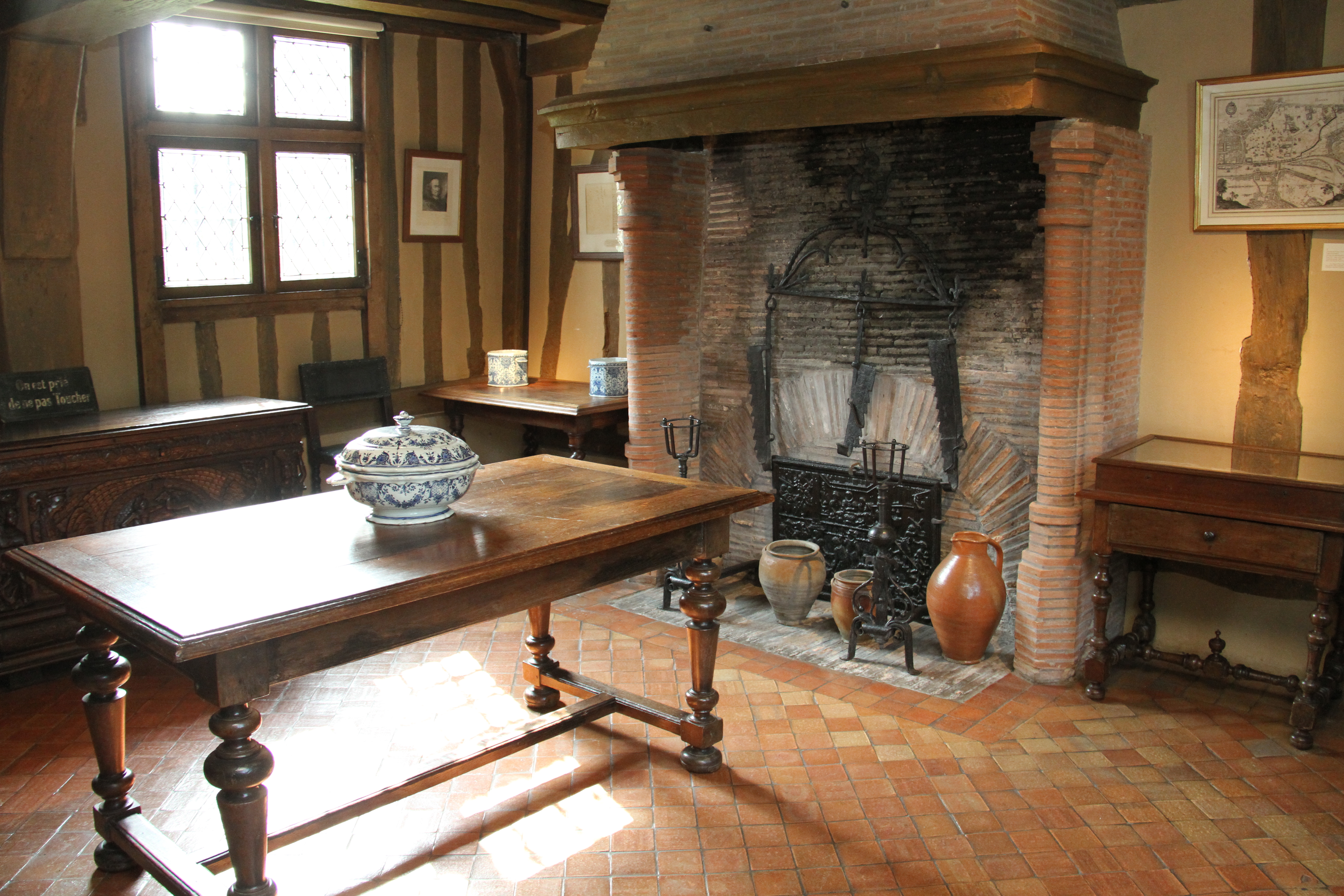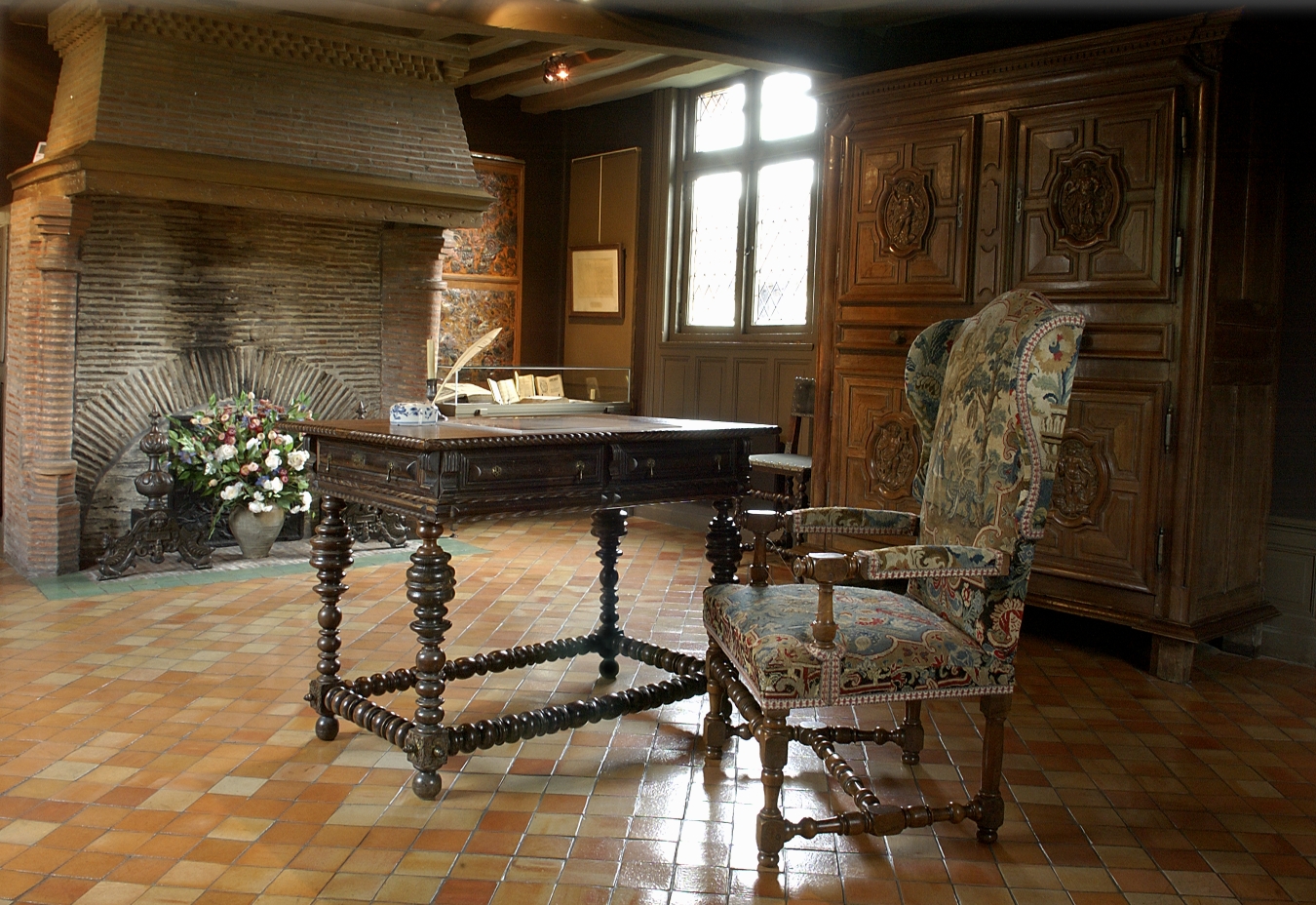Entrance hall
This first room has been present in the Maison des Champs since its 1608 purchase by Pierre Corneille's father, with views and postcards from the nineteenth and twentieth centuries.
Visitors are greeted by an imposing bronze with black patina, which was produced by the smelter Barbedienne (1810-1892) based on the model by J.J. Caffiéri in 1777. This was donated by the staff and pupils of the Lycée Corneille (a former Jesuit college that Corneille attended in Rouen) to mark the museum’s opening in 1879. The oak wardrobe is typical of seventeenth-century Normandy wardrobes. The oak chest, with its four sculpted evangelists, dates back to the mid-sixteenth century. In the display cases, documents and postcards from the beginning of the century show the house’s transformation into a museum.
The administrative records (purchases) and the village’s 1700 land use map are copies, as the originals are too fragile.

Dining room
Here we see a presentation of Pierre Corneille’s life, his role in Rouen, his studies, and his beginnings as a lawyer then as a writer, until his ennoblement in 1637.
In Corneille’s era, houses’ various rooms did not have a specific use, but it is clear that meals were prepared in one of the two ground-floor rooms.
The display recalls the history of the Corneille family in Rouen: a watercolour of the birthplaces on Rue de la Pie in Rouen, the Palais de Justice where Pierre Corneille sat as a young lawyer before publishing his first play Mélite inspired by a disillusioned love. There are also copies of the records of the baptism of Pierre Corneille, the ennoblement of his father in January 1637 just after the quarrel and success of Le Cid. The presence of the very sober small oak chest in this house since the seventeenth century is well documented.

Study: Corneille the writer.
In this room, you can find all aspects of his work, including a copy of L'Imitation de Jésus-Christ corrected by his hand, along with several original editions.
Of course, we do not know where in the house Pierre and Thomas Corneille were when they wrote their plays. In any case, this room was divided into three spaces before the museum opened.
The original “four seasons” wardrobe from the Rouen region dates back to the mid-seventeenth century.
The chair was added in 1880 and is a nineteenth-century replica of a seventeenth-century model, covered with seventeenth-century silk and wool upholstery on the theme of The Golden Fleece, in a nod to one of Pierre Corneille’s plays. The late-sixteenth-century gilded repoussé leather panels from the house of the Saint-Amand abbesses in Rouen are presented on two walls, reminding us that Pierre Corneille’s ancestors included generations of rich leather workers in Conches.
The portrait of Pierre Corneille is a copy by Charles Lebrun based on an original portrait painted in 1647, which would have belonged to his nephew Fontenelle. There were very few portraits created during the writer’s lifetime. The large number of nineteenth-century etchings are versions based on the 1647 painting or the one by Sicre in 1683.
Two display cases present a rotation of original editions of plays, whilst the third exhibits lesser-known religious publications including an edition of L’Imitation de Jésus Christ corrected in ink by Pierre Corneille.
Bedroom: La famille de Pierre Corneille (Pierre Corneille’s family)
Pierre Corneille’s descendants and ancestors are presented here, with a particularly prominent role given to Charlotte Corday.
The theme of this room is a tribute to Corneille, with the terra cotta model by David D’Angers (1831) of the monument currently located in front of the Théâtre des Arts on the waterfront in Rouen. The apotheosis of the bust of Corneille is a plaster model by Emmanuel Frémiet offered by the latter to the museum in 1884. In a display case you can see a selection of commemorative medals struck primarily in the nineteenth century.
The canopy bed is an eighteenth-century copy of a seventeenth-century model. It came from the convent of the Visitation of Rouen and was provided by M. Lavallée in 1981.
The small late-sixteenth-century dresser or cabinet described as “in the style of Androuet du Cerceau” was a novelty at the time, as the main item of furniture was the chest. This came from Île-de-France.
The clock comes from Saint-Jacques-d'Aliermont, the centre of Normandy clock making, and dates back to 1621.
Library:
This room presents Pierre Corneille’s brothers, Thomas and Antoine, his nephew Bernard Le Bovier de Fontenelle, and his contemporaries, including Richelieu, Racine and Molière.
Here you will also find numerous seventeenth- and nineteenth-century works, as well as some commemorative items.
Beyond exhibitions and files, this room enables us to take a look at Pierre Corneille’s contemporaries, as well as his brother Thomas, nephew Fontenelle (the first biographer of Corneille), his rival Racine and, of course, Molière.
Thomas Corneille (1625-1709) wrote more than forty plays, and during his lifetime was more famous than his older brother. He wrote two dictionaries aimed at popularising science, which were published at the end of his life, and also worked as a journalist for the Mercure Galant.
By marrying Marguerite Lampérière, the sister of Pierre Corneille’s wife Marie, Thomas became even more inseparable.
As for Bernard Le Bovier de Fontenelle (1657-1757), known as Fontenelle, he was the second son of Marthe Corneille, the two writers’ sister. Like his uncle Thomas, he entered the Académie Française and worked with the Mercure Galant.
Molière (1622-1673) and Racine (1639-1699), unfairly regarded as Corneille’s rivals, were not featured upon the museum’s opening in 1879. In addition, a new acquisition policy has been put in place. In fact, studies have since shown that Pierre Corneille was interested in Molière’s plays as early as 1643. The two Corneille brothers’ plays were included in the repertoire of Molière’s troupe in both Rouen and Paris.
Racine was definitely a more serious rival. Over the years, he then became more moderate, and it was he who delivered the speech marking Thomas Corneille’s admission to Pierre Corneille’s seat at the Académie Française in 1685.
Finally, we should note that included amongst the complete works of the Corneille brothers presented in the library is an edition commented on by Voltaire.
